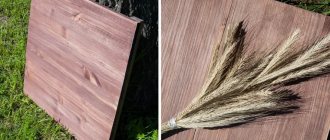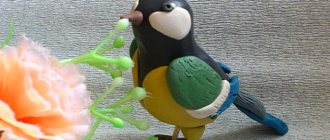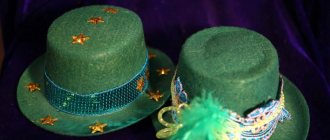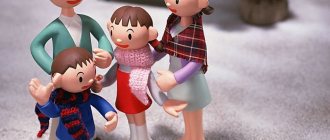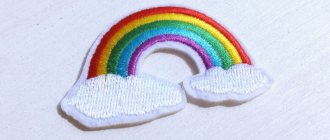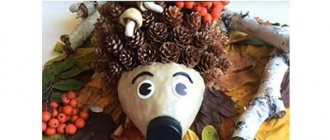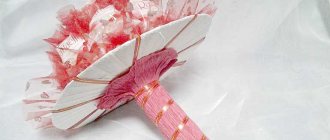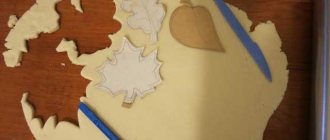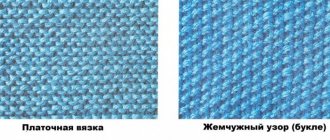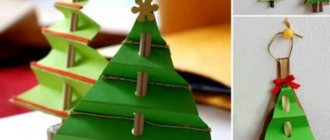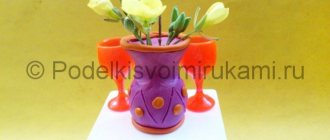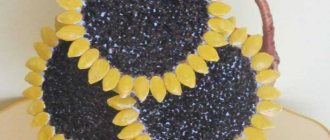Surely many children will enjoy a master class on how to make a house out of plasticine. “Building” a house will be an interesting game in itself. Children will be able to learn what and how a house is made of, and show their imagination in design and architecture. This craft can become a decoration or a game element. Having learned how to make plasticine houses, you can design entire streets and create cities for toys and dolls at home.
If you plan to keep the building for a long time and often play with it, then it is better to use polymer clay, which hardens in air. In any case, for a test craft it is better to take regular plasticine.
House made of plasticine. Step by step modeling lesson.
Modeling from plasticine is a fascinating and useful gymnastics for fingers and hands, so we continue interesting exercises.
We suggest making another toy from plasticine - a copy of an inanimate object. This will be a house. This version of the master class is quite simple, so even soft plasticine mass is suitable for work. 1. Select several shades of plasticine to imitate brick and tiles. There's also the task of creating windows and doors, so think about what color you'd like them to be. Also in this lesson, it is necessary to have a sharp spatula with a beveled edge.
2. A paper box of some kind will greatly facilitate the work of giving the house its shape. It is desirable that the base be square. For example, take a package of medicine, toothpaste or some other products. Cut two opposite sides, and fold the remaining two at an angle to form the roof of the house.
3. From the material selected for the walls, begin to form a cake, kneading it with your fingers.
4. Applying one of the walls of the house, circle it around with the tip of a spatula. The result should be a square, the size of which will correspond to the parameters of the paper wall.
5. Make four such squares and begin to attach them to the box, pressing them tightly with your fingers.
6. Decorate all the walls in the same way.
7. To sculpt the tiles, you can use red plasticine, diluting it slightly with black to dim the brightness. Create many oval flat pieces of the same size.
8. Start molding the roofing material onto the roof, pressing it tightly together.
9. Attach the next row with an overlap. Fill all the space in this way. Use a little more red plasticine to fill the gap on the back side.
10. To create the illusion of brick or cinder block on the walls, make a characteristic pattern with the tip of a spatula, arranging vertical stripes in a checkerboard pattern.
What to make
Before starting a lesson, every parent thinks about what can be made from plasticine. Imagine a little, imagine yourself as a child, think about what will interest your son or daughter most. Children's crafts may involve the use of many additional materials, which include: flowers, leaves, acorns, cones, and chestnuts.
Ideas for what can be molded from plasticine:
- Animals and birds. Interesting and funny hedgehogs, bunnies, and turtles will delight your little one. In addition, such plasticine crafts for children are made very quickly and simply.
- Thematic figures. Undoubtedly, for every child the New Year is a special, long-awaited event, because it is associated with toys and various gifts. Simple crafts made from plasticine in the form of a Christmas tree decoration, a snowman and, in fact, the Christmas tree itself will lift your spirits on the eve of the holiday.
- Flowers. Mesmerizing compositions made with a child will look as if they were alive. Depending on the age of the baby, you can make flowers with a minimum number of details, as well as more complex volumetric compositions.
- Trees. Having mastered easy crafts from plasticine, you can move on to more complex figures. Of course, a child will not be able to mold a tree on his own; he will need the help of an adult. But after taking a few steps in creating a craft, the child will be able to easily complete the job he started.
- Vegetables, fruits, sweets. Even novice craftsmen will be able to master the process of creating miniatures of their favorite delicacies. Select the necessary colors of plasticine, then you can safely start creating.
Isn't it fun and interesting to make crafts from plasticine with your own hands? Let's get started with this exciting activity right now. Prepare plasticine, glass, cardboard and some available materials and you can start working. We will teach you how to make a wide variety of crafts from colored plasticine; such an activity for kids will be entertaining and will cause a lot of positive emotions. Well, let's get down to business?
How to make a house from plasticine for dolls with your own hands with photos and videos
Surely many children will enjoy a master class on how to make a house out of plasticine. “Building” a house will be an interesting game in itself. Children will be able to learn what and how a house is made of, and show their imagination in design and architecture. This craft can become a decoration or a game element. Having learned how to make plasticine houses, you can design entire streets and create cities for toys and dolls at home.
If you plan to keep the building for a long time and often play with it, then it is better to use polymer clay, which hardens in air. In any case, for a test craft it is better to take regular plasticine.
small house
The house can be made in different ways and using different materials - boxes, bottles, glass jars, shells, pebbles, etc.
The easiest way is out of the box. For this you will need:
- plasticine set;
- small box;
- cardboard (for the roof);
- stacks;
- modeling board.
The box will act as a frame for the entire house or as a base for the walls. The roof can be part of the box, for example, in a box of milk (yogurt, kefir), you should only slightly trim the top “comb” and cut out the triangular parts (such a box is opened through these places). The roof can also be made from a sheet of cardboard or polystyrene foam.
Dollhouse
Every girl wants to have the most beautiful home for her favorite doll. However, such houses are quite expensive. It’s easier to apply your skills to inexpensive materials, and you’ll get a real miracle!
- fiberboard sheet;
- a set of colored paper;
- sheets of white and brown cardboard;
- glue and scissors;
- a piece of corrugated cardboard;
- pieces of wallpaper that are in the house.
On a sheet of fiberboard we draw an approximate sketch of the house and cut out the parts.
- We fasten them together with glue. The roof is constructed from corrugated cardboard.
- We cover the outer walls using sheets of colored paper of your choice. We make decorative markings on it.
- For additional decoration, brown cardboard rectangles imitating bricks are glued on.
- The entire structure is attached with glue to a blank cut from fiberboard for better stability.
- We use white cardboard for window frames. Having cut them out, we place them on the sides of all the windows.
- We also cover the balcony.
- The door with the door frame is made of brown cardboard.
- Interior wall decoration with prepared wallpaper or colored paper.
An amazingly bright house is ready to welcome its little owners!
Colorful house
You will need cardboard sheets, spruce (or pine) cones, colorless tape, a pencil and a ruler.
- Cut out 5 identical cardboard squares. Their size provides for the size of the planned house;
- carefully glue them together with tape;
- we make the roof from the same cardboard - we prepare 2 triangles, 2 squares, a rectangle; we connect them into a roof;
- We cut a napkin from bamboo slats into a square, coat one side with glue, glue the sticks, leaving small protrusions on both sides; We also treat all walls;
- we create a base for the roof from sticks;
- on the walls of the house we decorate the doors with sticks;
- create windows;
- We separate the scales from the cones and cut each one into a diamond shape, coat the parts of the roof with glue one by one, gluing the scales onto them. They create the appearance of tiles;
- We attach the roof to the base of the structure.
The result is a charming decorative house!
We create houses from old furniture
In our version, the dollhouse will be made from an old chest of drawers.
The work will also require: a wood saw, a brush and a brush, glue, white paint, putty, sandpaper.
We make a miracle with our own hands - a step-by-step master class
- If the chest of drawers is tall, you will have to remove the extra partitions, leaving two floors.
- Apply glue to the empty space that appears with a brush, lay wooden slats over it and leave to dry.
- In the meantime, we fill up scratches and gouges on the furniture with putty.
- After drying, sand the entire workpiece with sandpaper until smooth.
- We paint the entire miracle house white. Now it can fit all the dolls in the house.
House on three floors
This is a more complex craft, and the house will be on wheels.
Let's collect everything you need to build the structure: plywood sheets, a wood saw, an electric drill, a pencil, glue, a stapler, brown and gray paint, a paint brush, a primer, leftover laminate or pieces of linoleum. You will need wheels.
Let's start the creation process:
- The first step is to make a sketch according to the selected size. We cut out the marked elements, not forgetting to estimate the places on the walls for windows and doors.
- Now they need to be cut through. This is a job that requires patience and care.
- We are preparing the blocks for the windows. We connect them with a construction stapler and glue.
- We put the building on wheels.
- We paint the shelves brown.
- We treat the outside with a primer and let it dry. Paint it grey. The roof can be made in the opposite color for added color.
- We cover the shelves with laminate or linoleum.
The three-story house is ready with your own hands!
A hut on chicken legs
All children love fairy tales and their heroes, so building Baba Yaga’s house will be interesting for them.
You need to collect available materials: dry moss, conifer cones, plasticine, glue, dried berries, clothespins, leaves straightened with an iron.
- We glue the house from disassembled clothespins using Liquid Nails glue.
- We firmly fix the manufactured house on a cardboard, treat the free space of which with glue and “plant” moss on it.
- We decorate the roof with dry berries, leaves, and pieces of remaining moss.
- We paint the cones with green paint - these are Christmas trees, and we “seat” them on cardboard.
- We make forest animals - hares, squirrels, hedgehogs - from plasticine. Creating a forest picture around the hut is important for the overall background - Baba Yaga’s house, created with her own hands, is installed in a thicket.
Any material is suitable for making houses. Not only the usual paper, cardboard, plasticine, plywood, but also not quite ordinary materials: vegetables, old things, cake boxes, etc.
In addition, you spend a lot of time with your child, both of them are engaged in a pleasant activity that you enjoy. Ready-made houses delight children with their uniqueness, filling them with pride in their creativity and imagination. They play with special joy, using their crafts in games and showing them off to friends and guests.
All the houses discussed in the article are suitable for decorating an apartment without extra expenses.
Necessary materials:
- multi-colored plasticine;
- toothpick;
- modeling board.
Process description:
- From different colors of plasticine we roll 4 balls for filling the cake and proceed to forming the cakes. Lightly press each ball with your fingers on both sides and roll it into a barrel.
- We connect all the colors together, forming multi-colored layers, and align the edges again.
- Now, using a rolling pin, using a new color of plasticine, roll out a thin layer of such a size as to completely cover the cake. Place it in the center of the layer of cake.
- We connect the ends of the glaze together, and cut off the excess with a stationery knife.
- Roll out a thin sausage from white or beige plasticine and twist it like a rope - you get a wonderful creamy decoration.
- We attach the cream on top and at the base of the cake, cut off the excess and connect the ends.
- Then use the same stationery knife to cut the cake into pieces; if desired, you can cut out only one portion.
- Using a toothpick, give the brown plasticine cakes a loose sponge cake shape. If you don't have a toothpick, you can do this with an old toothbrush.
- If you have plastic small fruits, then decorate each piece of the cake with them. Now the doll delicacy can be served to the table.
Based on the principles of working with plasticine, you can invent other dishes. For example, children really like making sushi or pizza. In addition, you can always look for ideas in modeling from polymer clay. The only difference between this technique is that finished works made from clay harden, while those made from plasticine remain soft and are subject to deformation. In general, add a little imagination, a pinch of inspiration, a spoonful of perseverance to your work and create a new dish together with your child.
How to make a house from plasticine
How to make a house out of plasticine - my now eight-year-old son has been asking this question for several years now.
And at different times he built different houses and not only from plasticine. And not only at home. I myself don’t really like plasticine because of the residue it leaves on my hands, but Lesha always liked to sculpt, so I didn’t interfere or interfere too much. Again, our plasticine construction projects regularly alternated with various others, which, by the way, took place on very real construction sites, so everything was done for real. Bricks, mortar, masonry, trowels, putties - everything went into use. This is one of our construction projects, two years ago.
Last year there was another construction project, similar, in a different place, but this year, apparently, everything came together and this idea was born - to make a house out of plasticine. And also with such a thorough approach - bricks, mortar, gable roof, windows, door. And in the end the house turned out to be completely finished and quite simple and quick to manufacture - that’s what it means the child has gained experience.
By the way, it all started with monsters like these. They were made and redone several times, and now work is still underway, and, by the way, in these houses there are floors, communications, cables embedded in the walls, so it’s not so simple either!
Which plasticine to choose
Plasticine is a universal material for modeling. It is ready for use and does not require special processing. Plasticine is flexible and comes in a wide range of colors. A child can mix different colors of plasticine with each other, obtaining new shades. For children, you need to choose good quality material. It should not be too soft and not too hard. If plasticine sticks to your hands, then it will be impossible to sculpt with it. If it is too hard, then a child’s hand will not be able to knead it, and it will be difficult to connect the parts.
For younger children, it is better to purchase wax plasticine. Due to its base, it is more suitable for fragile children's hands; it is more flexible and soft. Regular plasticine can be purchased from the age of 3. We do not recommend giving flavored plasticine to children under 5-6 years of age. If yellow plasticine smells like lemon, red like berries, orange like tangerine, then the baby will have one desire - to try it. And this is not something you should learn in sculpting lessons.
What else will you need in class?
During modeling classes, in addition to plasticine, you will need the following tools and materials:
- stack;
- rolling pin for plasticine, possibly with patterns;
- modeling board;
- molds for modeling;
- pictures for “coloring” with plasticine.
Children over 3 years old can make crafts with natural materials. To do this, you should prepare pebbles, cones, twigs, and seeds in advance.
Plasticine crafts for children
But there is so much uncontrolled imagination in them that there is no point in describing the process of their creation. But here came the idea of making a plasticine craft as a gift for one of our loved ones. What should I do? A house, of course, is always a win-win idea, warm, sincere and cozy. Lesha did just that, literally spending a couple of hours on it. And suddenly it turned out great! This is the first house, and there is a well next to it.
And then he himself wanted to make the same one for me, for the woman, for my friend with whom we communicate closely, and for my dad’s beloved woman. Here, you can immediately see the circle of people dear to the child. And, characteristically, everyone has a birthday in the fall (mine is only at the end of August, but also soon), so the idea turned out to be very timely.
The process of creating a house from plasticine turned out to be so simple and understandable, that’s why the idea arose to show it in the article. Keep in mind, this is my son’s original technology, I didn’t add anything on my own, didn’t adjust it in any way - the way he came up with everything is the way it is. If something seems superfluous to you or, on the contrary, you want to do something differently, then everything is in your hands, there is no reason to restrain your creative impulses!
How to bake polymer clay in the oven
Beginners are hesitant to bake the product. But unfired clay is a fragile thing; in order to securely fix your work, you need to keep it at high temperatures. At first there may be a defect - if the clay is overbaked, it will burn and become covered with bubbles. If you take the product out ahead of time, it will not bake inside and will become fragile.
For the process to be successful, all parts should not be thicker than one centimeter. It is better to then glue the product together from many elements. They are burned by placing them on a toothpick. Spread crumpled foil on the bottom of the baking sheet and simply stick toothpicks into it. Large parts are laid out on paper, which is lined with a baking sheet. A regular A4 office paper size will do.
Baking temperature depends on the brand of clay. For Fimo it is 110 degrees and a time of 30 minutes. To know exactly what the oven temperature is, you should purchase a thermometer. They also bake prototypes and check them for fracture. After that, the temperature is increased for fragile products, and reduced for burnt ones.
How to make a house from plasticine
We take a piece of plasticine and begin to form bricks.
Everyone follows him. During the sculpting process, we level them so that they are the same in thickness and height.
When the first row is ready, we cut out the base of the house from cardboard to the size of the resulting blank.
Please note that we are not gluing the bricks together yet - these are still just blanks.
We continue to form bricks of the required size from plasticine. Three rows of masonry, the back wall is blank, there are two windows on the sides of the house, and a doorway on the front wall.
Now we form the bricks under the gables and use a special device to level them. I think the photos will give a good idea of this part of the process.
You can also use two plasticine stacks for leveling.
After this we make two more bricks for the pediment.
Now let's take care of the preparations for the roof. Cover a piece of plasticine with cling film to prevent it from sticking and roll it out with a rolling pin.
Knead with your hands evenly. And in general, in principle, you can do without a rolling pin and do everything with your fingers.
From the resulting plasticine sheet, cut out a rectangle of the required size.
We cut the second one to the size of the first one.
Using the same principle, we make a strip that will cover the very top part of the roof.
And now all the necessary building materials for a plasticine house are ready.
Now we begin to apply the “mortar” - dark plasticine - and lay the bricks.
When laying out the bricks, we level them using a stack and a hammer - with us everything is like at a real construction site.
We install and level the gables.
We form and fasten the roof.
We install the pipe on the roof.
And now our plasticine house is ready!
And not even one, but with them wells and trees.
White is plaster. There was an idea to seal the cracks with it.
So now we have a very specific answer to the question of how to make a house out of plasticine. And it’s very suitable for plasticine crafts for children 8-9 years old. Again, all close people are gifted with homes and attention, and my son has reached a new level in his creativity. Complete benefits from plasticine houses!
Which plasticine to choose?
Themed pictures on the theme “spring” for preschool children
The shelves of modern stores are overflowing with a variety of materials for modeling. They will contain:
- dough;
- modeling mass;
- homemade sand.
They are packaged in jars, because without them they dry out and crumble. This is not plasticine.
Classic plasticine is made from clay, fat and wax. Some manufacturers also do not indicate petroleum products on the packaging.
This material is sold in the form of bars or sausages; it does not deteriorate, does not dry out or crumble, even if stored without a box. The degree of hardness varies: from very soft to hard.
If we make crafts from plasticine with children who are 2 or 3 years old, then we buy soft material for the first time. It will not blur and at the same time it will be easy for the child to knead it.
It will be difficult for a beginning sculptor to work with hard plasticine, because his fingers are still weak.
If he wants to attach a flower bud to the stem, the parts will not connect, the child will get upset and quit this activity.
Read the useful article How to respond to children's tears>>>
Important! The material must be such that he can stick one piece of plasticine to another to build an image. Good quality plasticine will not delaminate, stick to palms, or stain them or clothes and furniture.
The child will be interested in working with bright materials
Good quality plasticine will not delaminate, stick to your palms, or stain your hands or clothes and furniture. The child will be interested in working with bright materials.
Give preference to plasticine packaging that states that it is non-toxic and hypoallergenic. It would be good if it was odorless.
Plasticine modeling for little ones
If there is a little mischievous child growing up at home, caring parents cannot do without plasticine. This magical material not only develops fine motor skills, helps expand the child’s horizons and creative abilities, but also perfectly trains perseverance, as well as the ability to finish a job.
In kindergarten, school or at home, modeling from plasticine is an indispensable activity. Therefore, first of all, today’s master class will be of interest to educators, teachers, parents, and, of course, to the youngest modeling enthusiasts.
Plasticine compositions every time take us to a bright fairy-tale world, where everything is tiny, fantastic and extraordinary. So let's give the kids magical moments by holding a plasticine modeling lesson. And parents can devote an evening to this activity, or use plasticine to make their entire children’s day off entertaining.
How to sculpt a house from plasticine
A small cozy house made of plasticine will decorate any interior, and the kids will surely like it. But the main thing is that in the process of sculpting the child will be able to show his own imagination, showing his sense of beauty.
To create a fairy-tale plasticine house you will need: multi-colored plasticine, pasta of various shapes, a glass jar (for example, for baby puree), and any other decorative decorations.
Everything is very simple:
1. Cover a glass jar with well-mashed plasticine. Let the child choose the main color of the house himself.
2. Make a window from small flattened yellow circles. Make a door on the other side of the house from brown plasticine.
3. Now, together with your baby, choose the color of the roof. Make a plasticine cone of sufficient size. Attach the roof by placing and firmly securing the cone onto the neck of the jar. If desired, cover the roof with multi-colored pieces of plasticine.
4. And the most interesting thing is to decorate the fairy house with pasta, pebbles, decorative flowers or beads.
Good gnomes probably live in this fairy-tale house. Now it would be nice to tell the kids a fairy tale about some fairy-tale hut and its incredible inhabitants.
This house will be a little more difficult for kids to make, but under the strict guidance of parents or the class teacher of a primary school, the children will cope with it without difficulty . A group craft made from plasticine is perfect for a school exhibition .
To make a house you will need: plasticine, pine cones, matches, a half-liter bottle, a stand (plywood, wood).
So, cover the bottle with blue plasticine, leaving gaps for windows and doors. Using white plasticine sausages, make a door, window frames and grilles. Make the roof from a plasticine cone (see instructions above) and decorate it with scales of fir cones.
Make a porch for the house from plasticine, matches and spruce scales, as well as a green plasticine lawn. Place, for example, these cute Moomintrolls in a house. Tell the kids who it is, or read a book with them about these fairy-tale characters.
Here's what a house made of plasticine and other materials :
And now we will learn how to sculpt houses from plasticine using the plasticineography technique. This is a kind of plasticine applique.
We fill the cardboard house blank or a schematic drawing on cardboard with a plasticine background.
Then, using plasticine flagella, we lay out the contours of the house, the window, and the roof. Plasticine balls will represent the logs of a log house.
We paint over the background, and voila - the plasticine house is ready!
And if you sculpt a house from plasticine on a cardboard blank, then at the end of the work you can glue a loop on the back side and use it in winter as a toy for the Christmas tree.
A funny plasticine cartoon will tell you how to sculpt a house out of plasticine . Let's see!
We make a fence from plasticine
Every decent house needs a plasticine fence. It's very easy to mold. Shall we try?
Offer to sculpt a fence from plasticine, for example, to kindergarten students. The fence sculpting lesson is designed to improve fine motor skills, consolidate knowledge of colors, and develop perseverance and accuracy.
For work you will need: plasticine and a modeling board.
Using pieces of plasticine using longitudinal movements of the palms, we make multi-colored thin columns and form a fence from them. Like this:
A very beautiful fence is made from plasticine and natural materials : twigs, sunflower seeds, acorns, etc.
Let's take a closer look at the process of modeling a fence from plasticine. We will make sunflowers from acorn caps and plasticine petals, and the center will consist of real sunflower seeds.
Decorate the fence with a tree and a bird made of plasticine and twigs.
Here you go! The plasticine fence is ready.
This is how colorful plasticine pet fences can be:
The video how to sculpt a fence from plasticine easily and simply :
Craft house: the best ideas from scrap materials. 130 photos and step-by-step master class
Making a house with your own hands is quite a complex and time-consuming job, but children and adults very often choose it. This toy can be used in a puppet theater and act as an independent decoration.
- Therefore, if you are already familiar with needlework, and your children know how to hold scissors and use glue, then you definitely need to make a beautiful house.
How to make a craft house: popular options and creation schemes
You can make a miniature house from different materials, but the principle of creation is practically the same. Of course, it’s better to start with light and simple options, and later, you can create a wooden dwelling.
Plasticine house
In order to make such a house, you will need plasticine. Yes, and nothing more. If you are creating a craft with kids, it is better to buy airy material. It's much easier to work with.
Make a square out of white plasticine - these will be the walls. Make two square cakes of the same size from brown plasticine - this is the roof. Also make a small pipe out of brown.
Now you can start creating the windows and front door. The front door can be made blue, and the windows can be decorated in the same color. Stick the door and windows onto the square. Place the roof and install the chimney.
You can decorate the house with green grass. For this you will need green plasticine. Roll out a small line and use a plastic knife to cut out the cloves. Glue the grass around the entire perimeter of the house.
Craft house made of cardboard
A cardboard house can be made more difficult than a plasticine one. But the work is so interesting that you will immerse yourself in the activity with pleasure.
We recommend reading:
Consumables:
- Two cardboard boxes of different sizes: large and medium;
- Two cardboard sheets for the roof;
- Glue;
- Scissors;
- Braid for decoration;
- Adhesive colored paper
- DIY house step by step:
- Stages of work:
- We take a large box and place it so that the open part faces you;
- This is a large room on the first floor. We cut out small windows with shutters on both sides;
- Let's start creating the second floor. For this we need a small box;
- We glue it to the large box in the same way so that the open part is facing you;
- On the second floor we form windows;
- Making a roof. To do this, take two cardboard sheets and glue them together into a house using tape;
- Let's start with the design. For this we need adhesive paper. We cover the walls. We glue the tape on the sides.
- The house is ready, you can move the doll in.
Paper house craft
Paper is the most common option for creating crafts. And the child becomes familiar with this material much earlier than plasticine.
Option 1. Application
To create an applique you will need colored paper, scissors and regular glue.
The first step is to make the blanks. To do this, take colored paper and cut out a square, a triangle, several small squares, a pipe, a cloud of smoke, a sun, a fence, a tree, grass, flowers.
We recommend reading:
These parts are cut from different colors. If you don’t know how to draw, then download diagrams and templates for a house craft on the Internet.
Once the pieces are ready, you can take the glue and start gluing. Take a white sheet of paper and glue each piece in its place. Any child can do this activity.
The picture is ready. Let it dry and feel free to send it to the competition.
Option 2. Log cabin
- This version of the house will be a little more complicated, but if you have experience, you can do it very quickly.
- Necessary materials:
We recommend reading:
- Sheets of white paper. It is best to take an office one, it is easier to work with;
- Colored paper;
- Scissors;
- Glue stick;
- Marker;
- Cardboard for the roof, you can use colored cardboard.
So, let's start creating the hut. First of all, we need to prepare the logs. To do this, take a sheet of paper and cut it into strips of the same width and length.
Using glue we form rolls from them. There should be 24 such logs, 6 for each wall.
We begin to assemble the frame. We lay the logs and immediately glue them. While the frame is drying, you can make a roof and cut out windows.
We cut out the windows from any colored paper, for example brown. You don’t need to cut just a straight rectangle; decorate it with patterns. This will make your hut look presentable.
The roof can be made from cardboard. Choose any color; a fairytale hut should be bright. We fold the cardboard in half and install it on the house.
The finishing touches remain. Using a marker, draw black lines. We get a hut made of birch.
House of ear sticks
A very easy craft, and the toy turns out to be very cute. And the photos of the house crafts will help you make the product the way you need it.
